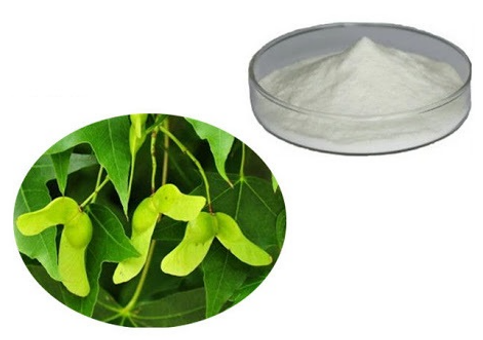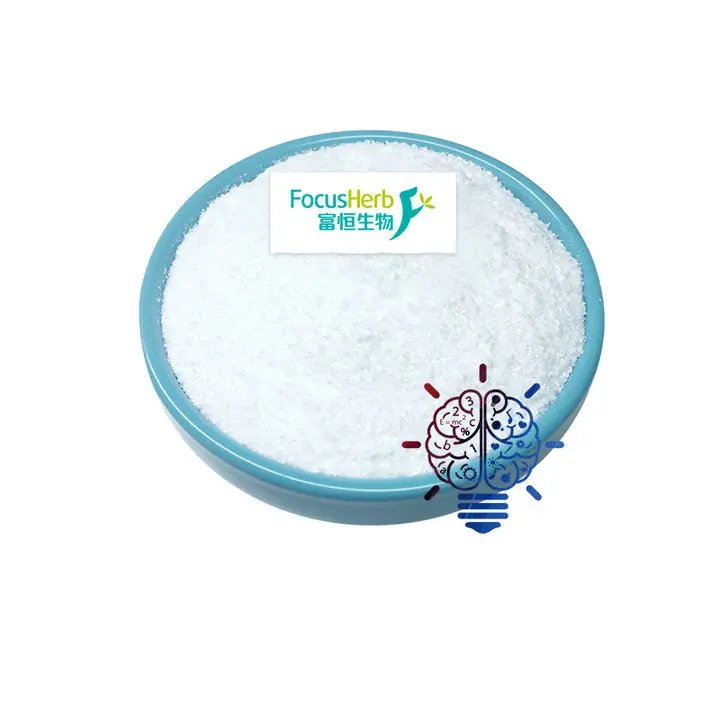Nervonic acid (NA), scientifically known as cis-15-tetracosenoic acid, is a substance that has garnered significant attention in the life sciences. Its unique chemical structure makes it an indispensable component of the body. At a molecular level, NA is a core lipid component of the myelin sheath and nerve cell membranes of the central nervous system, accounting for 20%-30% of the total fatty acids in the brain’s white matter. This high proportion is no accident; it signifies that NA is deeply involved in the fundamental construction and maintenance of brain function.
Nervonic acid, thanks to its carbon chain structure, specifically embeds itself within the phospholipid bilayer of the nerve cell membrane, like a key piece in a sophisticated jigsaw puzzle. This embedding directly influences membrane fluidity, which is in turn closely linked to fundamental physiological processes such as cellular material exchange and signal transduction. When membrane fluidity is optimal, cells can efficiently absorb nutrients and excrete metabolic waste, while also maintaining the correct conformation of various signaling proteins, enabling accurate and rapid signaling between nerve cells. If NA is absent or insufficient, membrane fluidity is disrupted, impairing the function of signaling proteins and, in turn, affecting the normal function of nerve cells.
Neurobiological Basis of Cognitive Function
Cognitive function is a complex and sophisticated set of functions in the human brain, encompassing learning, memory, attention, language, and thinking, among other aspects. The realization of these functions relies on the sophisticated structure of neuronal networks and efficient signal transmission mechanisms.
From the perspective of structural integrity, synaptic density and myelin integrity are key indicators of neuronal network quality. Synapses are the key connection points for information transmission between neurons, and their density determines the complexity of neural connections. More synapses mean that neurons can establish more extensive and detailed connections, thus supporting higher-level cognitive activities. For example, when learning new knowledge, the brain stores information by strengthening and adding new synaptic connections. The myelin sheath acts like an insulating layer around nerve fibers, ensuring the rapid and accurate transmission of neural signals. When the myelin sheath is damaged, signal transmission speed decreases significantly, just as damaged insulation on an electrical wire causes leakage, and cognitive function is subsequently affected. For example, patients with multiple sclerosis experience symptoms such as limb movement disorders and cognitive decline due to myelin damage.
At a functional level, neurotransmitters act as messengers of information. Neurotransmitters such as acetylcholine and glutamate transmit chemical signals between neurons. Their concentrations and receptor sensitivity are crucial for information encoding and storage. When we attempt to recall an event, the relevant neurons release specific neurotransmitters, which bind to receptors on the receiving neurons, triggering a series of biochemical reactions that lead to memory retrieval. Abnormal neurotransmitter concentrations or altered receptor sensitivity can hinder memory retrieval. For example, decreased acetylcholine levels in the brains of patients with Alzheimer’s disease lead to severe memory loss.
Neuronic acid, by optimizing both its structure and function, has become a core target for improving cognitive function. It provides the necessary material foundation for synaptic formation and stability, participates in the synthesis and repair of myelin sheaths, and ensures a stable neuronal network structure. Furthermore, it regulates the synthesis, release, and metabolism of neurotransmitters, maintaining a balanced neurotransmitter system and ensuring efficient information transmission between neurons, thereby safeguarding normal cognitive function.
Three Core Mechanisms of Neuroacids in Improving Cognitive Function
(I) Neuronal Regeneration and Synaptic Remodeling
In the mysterious “universe” of the brain, neurons are like twinkling stars. Their new birth and remodeling of connections are the critical “infrastructure” for improving cognitive function, and neuroacids are the exceptional “builders” of this grand project.
Neuroacids initially focus on neural stem cells, the brain’s “universal cells” with the potential to differentiate into various types of neurons. By activating the Wnt/β-catenin signaling pathway, neuratoic acid acts like a rallying cry, promoting the rapid proliferation of neural stem cells. In animal experiments, researchers were surprised to find that treatment with neuroacids significantly increased the number of new neurons in the dentate gyrus of the hippocampus, a brain region closely associated with learning and memory, by 30%-40%. These new neurons, like a fresh infusion of blood, expand the “hardware capacity” of memory storage, providing the brain with more “storage space” to accommodate new knowledge and experiences.
In addition to increasing neuronal numbers, neuratoic acid’s enhanced synaptic plasticity further enhances cognitive function. At the presynaptic membrane, it acts like a precise commander, increasing the expression of the vesicle-releasing protein SNAP-25. This change increases the release of the key neurotransmitter acetylcholine by 25%, essentially increasing the number of “messenger” for signal transmission and enabling faster information transmission. At the postsynaptic membrane, neuratomic acid enhances the phosphorylation of NMDA receptors, significantly increasing long-term potentiation (LTP). LTP is a key physiological mechanism for learning and memory formation. It acts like a “highway” between neurons, allowing for high-speed and efficient transmission of neural signals, enhancing the encoding efficiency of the learning-memory neural pathway and making it easier for us to learn and remember new information.
(II) Myelin Repair and Signal Transmission Acceleration
The myelin sheath, the insulating layer surrounding nerve fibers, plays a crucial role in nerve signal transmission, and neuratomic acid is an indispensable “key” in myelin repair and signal transmission acceleration.
From a material perspective, neuratomic acid is a key precursor of myelin sphingomyelin. When demyelination occurs, Nervonic Acid acts like a timely rain, rapidly participating in the reconstruction of the lipid bilayer in demyelinated areas. In a multiple sclerosis model, supplementation with Nervonic Acid significantly increased myelin repair by 40%, and nerve conduction velocity returned to 85% of normal levels. This data clearly demonstrates the powerful role Nervonic Acid plays in promoting myelin regeneration. It provides direct “building blocks” for myelin repair, allowing damaged myelin to be rebuilt and ensuring the smooth flow of essential pathways for neural signal transmission.
Restoring myelin integrity not only repairs structure but also improves function. A healthy myelin sheath reduces ion leakage, increasing the conduction velocity of impulses between nodes of Ranvier by 15%-20%. Complex cognitive tasks require the coordinated work of multiple brain regions, like a delicate symphony. The increased signal conduction velocity following myelin repair can significantly improve the efficiency of signal coordination across these regions, allowing for smoother communication between them and enabling more efficient performance of complex cognitive activities such as thinking and analysis.
(III) Anti-inflammatory and Antioxidant Regulation of the Neural Microenvironment
The brain’s neural microenvironment is like the “soil” that nourishes neurons. Its health directly impacts their survival and function. Neuroacids act as guardians of this “soil,” creating a stable and healthy home for neurons through their anti-inflammatory and antioxidant properties.
In terms of inflammation regulation, Nervonic Acid precisely targets the NF-κB pathway. When the brain is affected by factors such as injury and aging, microglia become overactivated, releasing large amounts of pro-inflammatory cytokines such as TNF-α and IL-6. These cytokines act like “troublemakers,” inducing neuronal apoptosis and synaptic loss, severely impairing cognitive function. Neuroacids, however, act like a “tight ring” around these “troublemakers,” reducing levels of pro-inflammatory cytokines like TNF-α and IL-6 by 35%-40%, effectively inhibiting the inflammatory cascade, preventing inflammatory damage to neurons and synapses, and maintaining a stable neural microenvironment. In the face of oxidative stress, the “invisible killer” of neurons, Nervonic Acid actively strengthens the antioxidant defense system of neurons. It increases the activity of antioxidant enzymes such as SOD and GSH-Px. These enzymes, like courageous “scavengers,” can quickly eliminate excess ROS (reactive oxygen species). Under the action of Nervonic Acid, the content of MDA (lipid peroxidation products) in neurons decreases by 28%. This reduction in MDA protects the DNA and mitochondria of neurons from oxidative damage, acting like a protective layer for the core “components” of neurons. This slows down the aging of neurons, allowing them to continue to function efficiently and effectively, and providing a solid foundation for normal cognitive function.
Cognitive Improvement Across the Lifespan
(I) Childhood Development: A “Golden Boost” for Intellectual Development
During a child’s developmental journey, the ages of 0-6 are considered the “golden age” of brain development, like a beautiful painting waiting to be painted. Neuroacids are the most crucial ink in this painting, adding a vibrant touch to intellectual development.
During this critical period, neuroacids’ promotion of dendritic branching is like magic. Through rigorous experiments, researchers have observed that supplementation with neuroacids significantly increased dendritic branching and synaptic density by 22% compared to the control group. These densely packed synapses act like countless “information bridges,” building a more complex neural network. This microscopic change has led to tangible score improvements on the Wechsler Intelligence Scale (WAIS), with children achieving significant gains in verbal comprehension and spatial reasoning. They are able to more quickly understand new vocabulary and express themselves more eloquently. They also demonstrate enhanced spatial perception and construction skills in activities like puzzles and building blocks, as if the “gateway to wisdom” in their brains has been quietly opened by neuroacids. As children enter school and learning becomes a primary focus of their lives, Nervonic Acid plays a key role in laying the foundation for learning and memory. Clinical studies provide valuable evidence. School-age children who supplemented with Nervonic Acid for six months experienced an 18% improvement in word recall accuracy, allowing them to easily master words that previously required repeated recitation. They also experienced a 15% increase in math calculation speed, enabling them to more quickly solve math problems on exams. Functional magnetic resonance imaging (fMRI) reveals the underlying physiological mechanisms behind this. Neuroaminic acid supplementation increased glucose metabolism in the hippocampus, indicating that this critical hub of memory receives more energy, enabling more efficient encoding, storage, and retrieval of information, laying a solid foundation for children’s learning.
(II) Golden Age of Adulthood: The “Endurance Engine” of Efficient Cognition
In adulthood, people face multiple challenges in work and life. Intense mental effort is like a long-lasting marathon. Neuroaminic acid acts as the “endurance engine” of efficient cognition, continuously providing the brain with power. For those who engage in chronic, high-pressure, intellectual work, Nervonic Acid has a significant impact on enhancing attention and executive function. In a carefully designed double-blind trial, after four weeks of daily supplementation with 200mg of Nervonic Acid, participants’ working memory capacity (N-back test) increased by 1.2 units, essentially increasing the brain’s “temporary storage space” and enabling them to process more information simultaneously. Distractions decreased by 25%, allowing them to focus more effectively on complex tasks and be less easily distracted. Blood oxygen utilization in the prefrontal cortex increased by 19%, indicating that the brain’s “decision-making center” receives a more adequate oxygen supply, resulting in sharper thinking, more efficient planning and problem-solving, and greater execution and creativity at work.
When faced with stressful events in life, Nervonic Acid becomes a stabilizing force for maintaining cognitive stability. By regulating the activity of the hypothalamic-pituitary-adrenal (HPA) axis, it cleverly reduces the toxic effects of cortisol on hippocampal neurons. Under stress, the decision-making error rate decreased by 30%, significantly reducing errors that might otherwise be made due to nervousness. Information processing speed retention increased by 22%. Even under pressure, the brain can analyze and process information quickly and accurately, allowing people to remain calm in the face of difficulties, make wise judgments and choices, and calmly cope with life’s challenges.
(III) Protective Period in Old Age: A “Brake” for Cognitive Decline
The wheel of time relentlessly turns, and the shadow of cognitive decline looms in old age. However, neuratomic acid steps forward, acting as a “brake” for cognitive decline, safeguarding the brain health of the elderly.
In the mild cognitive impairment (MCI) stage, timely intervention is crucial, and neuratomic acid has demonstrated remarkable effectiveness in this regard. In a study of MCI patients, continuous neuratomic acid supplementation for 12 months resulted in a 2.3-point increase in Montreal Cognitive Assessment (MMSE) scores. This seemingly small increase represents a significant improvement in cognitive function, with patients showing significant gains in memory, attention, and language skills. At the same time, the rate of hippocampal volume shrinkage slowed by 40%. As a brain region closely associated with memory, this slowed decline in the hippocampus protects this “storehouse” of memory, significantly reducing the risk of developing Alzheimer’s disease and allowing older adults to maintain relative independence and enjoy a fulfilling twilight year.
Mechanistically, neuratomic acid has demonstrated a powerful ability to combat the risk of Alzheimer’s disease (AD). Like a valiant warrior, it inhibits Aβ protein aggregation and tau protein hyperphosphorylation. In experiments with APP/PS1 transgenic mice, the addition of neuratomic acid reduced the number of amyloid plaques in the brain by 35%. These plaques are a hallmark pathological feature of AD, and their reduction signifies a clearing of the brain’s “garbage pile.” In behavioral testing, the number of spatial memory errors in mice decreased by 28%. Mice previously lost in a maze were more accurately navigated by neuratomic acid. This demonstrates the effectiveness of neuratomic acid in improving spatial memory in AD model animals and offers new hope for the prevention and treatment of AD.
Future Research and Industry Outlook
(I) Frontier Exploration Directions
In the field of Nervonic Acid, a series of cutting-edge research directions are gradually unfolding, promising further breakthroughs in improving cognitive function.
The development of trans-blood-brain barrier delivery systems has become a research hotspot. The blood-brain barrier (BBB), like a strong defense line for the brain, restricts the entry of many drugs into the brain. The development of nasal formulations offers new possibilities for circumventing this limitation. The nasal cavity and the cerebrospinal fluid have a unique connection, allowing some drugs to enter the cerebrospinal fluid after nasal instillation. Studies have shown that the development of nasal formulations can increase drug concentrations in the brain by threefold. By optimizing the formulation and using nanotechnology to encapsulate Nervonic Acid in a special carrier, researchers are enabling it to better penetrate the nasal mucosa and reach the brain directly via the olfactory nerve pathway, providing a more efficient drug delivery route for the treatment of brain diseases.
Research on gene-nutrient interactions is also deepening. Apolipoprotein E (APOE) gene polymorphisms are closely associated with cognitive function, and APOEε4 carriers have a significantly increased risk of Alzheimer’s disease. Exploring personalized neuratomic acid supplementation regimens is crucial for this population. Researchers are studying the synergistic effects of neuratomic acid and omega-3 fatty acids, hoping to provide more effective cognitive protection for APOE ε4 carriers through targeted nutritional interventions. Studies have found that DHA and EPA in omega-3 fatty acids can regulate the fluidity and stability of neuronal cell membranes. Working together with neuratomic acid, they may further enhance neuronal function and reduce the risk of cognitive decline.
The integration of digital biomarkers is another cutting-edge area in neuratomic acid research. Electroencephalogram (EEG) signals reflect the brain’s electrical activity. Through EEG signal analysis, it is possible to quantify the effects of neuratomic acid on cognitively relevant EEG frequency bands (such as alpha and beta waves). In one study, researchers performed EEG tests on subjects after neuratomic acid supplementation and found a significant increase in alpha wave power, indicating improved brain relaxation and concentration. This approach allows for a more objective and accurate assessment of the cognitive benefits of neuratomic acid, providing a more scientific basis for its clinical application.
(II) Industry Development Recommendations
To promote the healthy development of the Nervonic Acid industry, efforts must be made to standardize quality control, innovate functional foods, and accelerate clinical translation.
In terms of standardized quality control, establishing GC-MS fingerprint standards for Nervonic Acid raw materials is crucial. Gas chromatography-mass spectrometry (GC-MS) technology enables precise analysis of Nervonic Acid components. By establishing fingerprint standards, Nervonic Acid purity (≥98%) and trans-isomer limits (<0.5%) can be standardized. This not only helps ensure the quality stability and consistency of Nervonic Acid products, but also improves product safety and efficacy, enhancing consumer trust in Nervonic Acid products.
Functional food innovation is a key development direction for the Nervonic Acid industry. Developing Nervonic Acid-containing infant formula and special medical foods for the elderly and middle-aged has broad market prospects. Adding Nervonic Acid to infant formula can meet the nutritional needs of infants and young children for brain development and promote intellectual development. Meanwhile, Nervonic Acid in special medical foods for the elderly and middle-aged can help improve cognitive function and prevent cognitive decline in the elderly. Combining DHA, phosphatidylserine (PS), and other ingredients to create a “brain health complex” further enhances the product’s effectiveness. DHA is a vital component of the brain and retina, crucial for the intellectual and visual development of fetuses and infants. PS boosts neurotransmitter levels, enhancing memory and concentration. Combining these ingredients with Nervonic Acid creates a synergistic effect, providing consumers with more comprehensive brain health support.
As the “structural lipid code” of the nervous system, Nervonic Acid is moving from basic research to precise application. Its multi-dimensional cognitive benefits not only lay a solid foundation for children’s intellectual development, but also provide a new strategy for cognitive protection in the elderly. With the iterative upgrade of delivery technology and clinical evidence, this natural active ingredient is expected to become a “strategic nutritional factor” in the field of cognitive health, leading a health revolution from disease intervention to cognitive management throughout the life cycle.






















